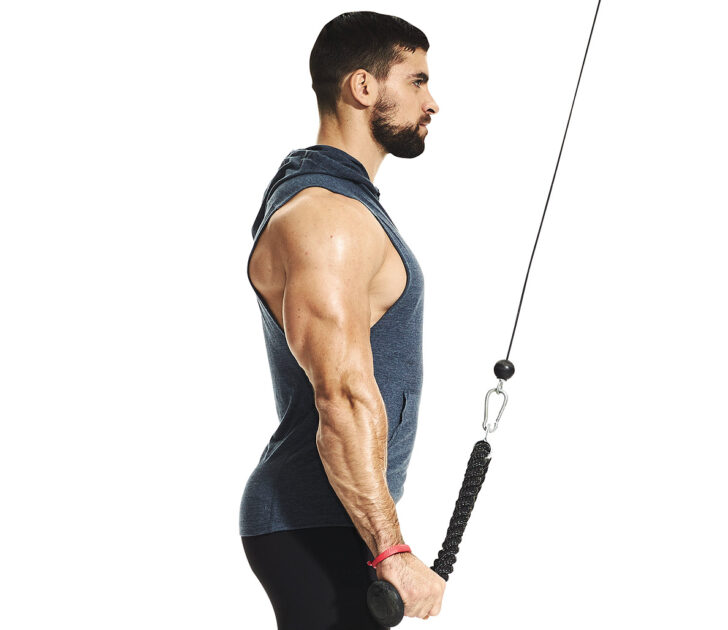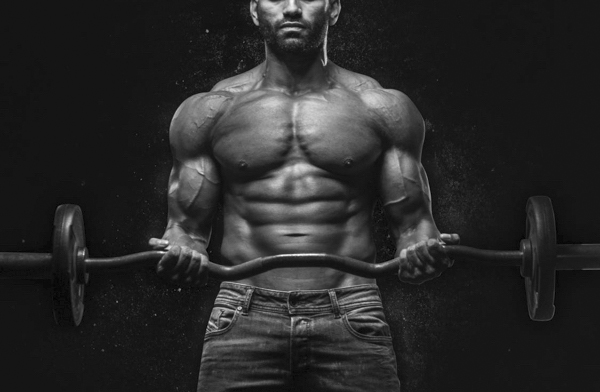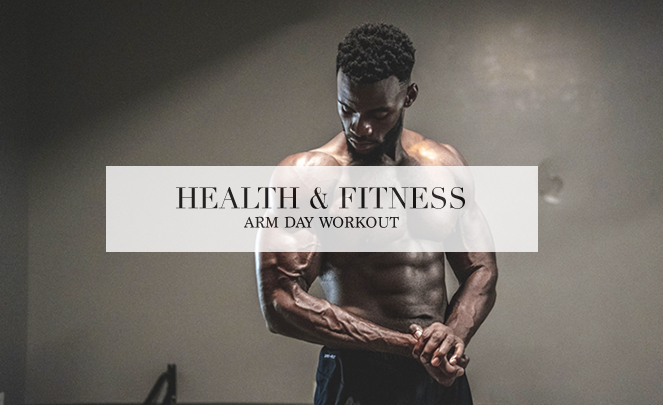Looking for thick, highly developed arms? Most men place huge emphasise on arm training with the goal to get muscular arms that rip out of their sleeves. However, despite the effort so many fail at reaching these goals.
Often is the case that people will put together a workout program that includes arm training at least once a week. Working out your arms once a week is perfectly fine, you can build exceptional arms by just training them once a week. Yes, it may not necessarily be the most optimal strategy if you want to get your arms more developed and increase the size of them, but they will grow.
Now, where many fail in reaching their arm development goals is that they may not approach arm training the same way as they approach, say their chest training, or back training for that instance. Often, training arms is relegated to the end of your workout session. For example, a typical split could be back and biceps on one day and chest and triceps on the second.
Typically people will focus on their chest and back in each of these workouts, with arms (biceps and triceps) being a second thought. With enough time and consistency in training, you will see some good development, but subsequently, there will likely be a point in which your arm development plateaus. The reason why is simple. You are not placing the arms under enough tension and stress. By placing the arm training phase of the workout at the end, where you are effectively fatigued to some great degree, you will lower your ability to place more mechanical stress or tension over the working muscle, in the case the arms.
One effective strategy to ensure a more balanced workout is to rotate the order of exercises you perform within your workout program. So the next time you come to workout your back and biceps, try placing some bicep exercises to the beginning of your workout.
Arm Training Specialization
Changing the order of your exercises in a chest & triceps or back & biceps workout can ensure arm growth and development while also allowing you to maximise the number of the training session you can perform on a particular muscle or muscle group in a given week. You are essentially condensing a group of muscles into one workout, rather than splitting them up into many workouts.
However, you may still come to a point where growth and development have slowed or stopped. If this is the case, then you will need to dedicate a whole workout just to arm training alone.
Biceps and Triceps Workout
This workout should be performed within about 45 minutes in total. Keep the rest periods short; 30 seconds to 1 minute maximum.
This workout will alternate between your triceps and your biceps, giving you enough time to sufficiently recover so that each exercise is performed with greater effect over the target muscle.
The Triceps Pushdown (Rope)
The first exercise in this arm day workout is the triceps pushdown using the rope attachment fixed to the cable machine. The muscle worked in this particular exercise is the triceps, however, there are three heads to the triceps muscle. Each head is located at different positions over the humorous bone and each bears different tension loads depending on the angle of the force applied when the triceps muscle is utilised during a movement.
This exercise, when performed with the correct technique, should stimulate more of the lateral head of the triceps muscle.

Triceps Pushdown Instructions
How to perform the triceps rope pushdown?
- First, fix the rope to the cable machine. Then fix the cable machine to a height in which you can get into the starting position with relative ease and at the same time enables you to receive a full stretch on your triceps when you lower the weight back down. Many people fix the position so that during each rep, when the weights come back down, they end up smacking into one another. You want to maintain separation between the weights that are moving up and down on the cable machine and the racked weights at the bottom. This should ensure that your triceps muscles receive a full stretch as you lower the weight and raise your arms back up. Furthermore, this will prevent you from resting and losing tension in the triceps as the weighted plates move down and your arms raised.
- The next phase is body posture. Your back should be straight, legs slightly bent to allow for greater stability and lean slightly forward and tense your core.
- Pull the rope down driving the elbows down to your sides. Then engage your lats – this is important to minimise movement in your shoulder, helping you to maintained good form through the entire movement. What tends to happen is your humorous will often come up during the eccentric (lengthening) phase of the movement, engaging the lats throughout the entirety of the exercise will aid in stability and help keep tension on the target muscle.
- The only joint that should be moving in this exercise is the elbow joint. Once in the starting position, drive the rope down focusing on engaging the target muscle, specifically the lateral head of the triceps.
- When your arms are fully extended twist the out at the bottom by rotating your wrist counterclockwise. Again, focus on squeezing the lateral head as hard as you can.
- Then controllably lower the weight back down, ensuring that your body stays steady with the only moment coming from the elbow joint.
- Repeat the movement for the required reps.
Your first set should be a warm-up set, so set the weight low and perform about 15 reps.
Then you are going to perform 4 working sets of a moderate-to-heavy weight. Try to increase the weight load on set two and three only if you maintain strict form. As you increase the weight you will have to reduce the reps.
On the fourth and final set, drop the weight back down to either the same as the first working set or a slightly less. With the significant reduction in resistance, you should have greater awareness over the contraction of the target muscle, especially as it should now be reasonably pumped and swollen.
This fourth set is about maximising the tension and pump. As you drive the rope down, you want to squeeze as hard as you can, so that you feel a sharp pain in your lateral triceps. Hold the position for a split second, then lower the weight again and repeat.
Single-Arm High Pulley Biceps Curl
This exercise will help to improve the strength of the biceps brachii at its shortest position, strengthening its insertion at the shoulder. You may not know but, the biceps brachii is at its very shortest when you lift your arm and curl your arm behind your head. On the other hand, a fully lengthen biceps brachii is reached when you extend your arm back behind you (similar to an incline dumbbell curl), but with a straight arm.
Single-Arm High Pulley Biceps Curl Instructions
- Attach a single handle to the cable machine with the machine set to a high position. Set or peg the weight to the required load.
- Grab the single handle and step away from the machine a few paces, if possible having something to grab hold of and fix yourself to with the free hand. This will help to maintain stability and control higher resistance. You should step away enough so that you can fully extend your biceps while maintaining tension on the target muscle – the plates should not touch as they drop back down.
- Tense your core and with your working arm out at the side you want to slightly elevate your arm so that there is some tension applied to your biceps before you even begin to curl.
- Next, curl the arm in towards you, squeezing your biceps as much as you can at the peak of the contraction. To maximise tension on the insertions at the shoulder, you can lift you shoulder up only when you have fully curled your biceps. You should notice a high degree of tension where the biceps meets the shoulder. Once achieved, lower your shoulder first, then in a controlled manner allow for your arm to straighten for the eccentric phase of the movement.
- Perform the same movement for the required reps and sets.
Start of light for this movement and ensure that you first warm up the muscles. Often, you see people going heavy, too a point where they lose form and do not achieve maximal tension onto the target muscle. So, start light and carefully increase the resistance as your strength increases over time.
You should follow the same strategy as the previous exercise in regards to the sets and rep range. Start light and increase the resistant as you go from set one to two and again from set two to three. Your fourth set should with reduced resistance, focusing on maximising the intensity of the contraction over biceps muscle.
One-Arm Cable Triceps Extension
There are a variety of ways in which you could execute the one-arm cable triceps extension. In each case, you find that they emphasize different stages of the strength curve. That could be at the initial stage of the movement, the mid-range of the movement, or at the farthest point in the movement – typically the peak of the contraction.
In this case, under this exercise, your goal is to maximise the tension at the farthest point in the movement, not only that, this exercise will place your triceps under their shortest muscular contraction possible.
Now, this exercise is somewhat similar to a triceps kickback in action and how it contacts the target muscle. However, with this particular method, you will have greater control and improved stability as your body is in an upright position rather than a bent-over position in the classic triceps kickback.
One-Arm Cable Triceps Extension Instructions
- Start without any elements attached to the cable, just the carabiner clip is necessary for this exercise. Set the cable to a mid-high position.
- Set the weight on the machine.
- Grab with one hand the end of the cable, just above the carabiner.
- Step back from the machine about 2-3 feet so that cable is pulled out with your back straight, knees slightly bent, and core engaged.
- Next, you want to drive your elbow back behind you as far as it can go. Keep the elbow in that position for the entirety of the movement and every rep – it should not come forward at all.
- Finally, with moving only the elbow joint, engage your triceps and extend the cable back behind you so that your arm is fully stretch out and so that your triceps are fully contracted. Squeeze as hard as you can at the peak the contraction – it should be somewhat painful in the triceps muscle.
- Once, you have reached peak contraction slowly, with only moving the elbow joint, let the cable defend back down to the starting position. Repeat this action for the number of reps required.
Incline Dumbbell Curl
The incline dumbbell curl targets the long head of the biceps brachii muscle. Moreover, due to the angle in which the arm is positioned throughout the movement, a deeper stretch is induced in the biceps during the negative phase of the dumbbell curl.
Incline Dumbbell Curl Instructions
- Position the incline bench at 30-50 degrees, the lower the angle the more the movement recruits the long head of the biceps.
- Sit upright with your back against the pad.
- If you are performing the exercise on one arm at a time, ensure that you use your free hand to firmly grip the seat of the bench. This will help lock your body into a stable position, keeping your lumber in a straight upright position.
- Holding the dumbbell with a supinated (palms up) hand begin to curl it up towards your shoulder, ensuring that only the elbow joint moves during this exercise.
- Once you have raised the dumbbell up, with the biceps fully shorten and contracted, and a supinated hand, farther twist your wrist counterclockwise, raising your little finger as much as possible. You should notice a much greater contraction of the biceps using this technique.
- Finally, lower the dumbbell back down into the starting position in a controlled manner. Repeat for the required number of repetitions.
Overhead Cable Triceps Extension
Though the overhead cable triceps extension does work the entire triceps muscle, there is a greater emphasis on the long head of the triceps specifically.
There are two key aspects of this particular exercise. The first is that it places the triceps muscle into its most elongated, or stretched state possible. This is achieved when the arms are stretched out above your head, which you may notice stretches your triceps brachii to some degree. Then, whilst keeping the humerus at the same position, flex at your elbows so that your hands come down towards your shoulders. You should now notice a further stretch on the triceps.
The second point is regarding the strength curve. This exercise will be at its most challenging at the initial phase of the movement. That is the point in which arms are bent back with the triceps fully extended.
Overhead Cable Triceps Extension Instructions
- Attach a rope to the cable and set the stack as high as possible on the cable machine.
- Grab with both hands the rope with a neutral grip and face away from the machine.
- Brace your body, keeping your core tight. Step forward assuming a spit stance. For extra leverage and support plant the back of your foot against the base of the cable machine.
- Lean forward slightly at the hips and keep your elbows in a fixed position.
- Initiate the movement by flexing the triceps, ensuring only the elbow joint moves.
- Extend the rope down until the elbows are almost locked and the triceps muscles fully flexed, then slowly lower the rope to the starting position.
- Repeat the action for the required number of repetitions.
EZ Bar Biceps Curls
Although the EZ bar biceps curl targets the biceps, there are other muscles involved, namely the brachialis and brachioradialis, which is utilised more in this exercise than the previous. This is due to the more natural grip – less supination of the hands – which still hits the biceps but, as mentioned, will recruit to a large extent the brachialis and brachioradialis too.
In regards to the strength curve, this exercise will be at its most challenging at the mid-point of the movement. Stimulating the muscle greater at the mid-point range-of-motion will promote all-round development when we combine the previous two biceps exercise, which targets the ends of the movement.

EZ Bar Biceps Curls Instructions
- Grasp the EZ bar at shoulders width apart using an underhand grip.
- Stand up straight, back flat, elbows to your sides, and arms fully extended.
- Keeping your elbows tucked in to your sides close to your torso, slowly curl the bar up.
- Squeeze the bar at the top of the movement as hard as you can then slowly lower the bar back down, ensuring that you keep your elbows slightly bent at the bottom to maintain tension throughout.
- Repeat the movement for the required repetitions.
Tricep Dips
Weighted dips are a great compound movement and should always be included in any good tricep workout.
Unlike many other tricep exercises, the dips hit every head of the triceps muscle: long, medial, and lateral. It will help to build strength and size over the entirety of the triceps muscle and help build up the stabilising muscles also.
A couple of tips:
- Many lifters will utilise the dip to target the lower chest. This involves leaning forward during the dip to place tension onto the lower pectoral. To target the triceps you must minimise chest activation. That means you must stay upright (vertical) throughout the movement.
- The bars should be narrow. If the bars are wide apart, your elbows will often flair out. This takes tension away from the triceps, causing greater chest activation. You should be aiming to get your elbows straight back behind you. Using a narrow bar will allow you to accomplish this with greater ease.
- Try to dip as far as you can. Many lifers will not complete a full range-of-motion for this exercise. This might be due to discomfort or poor technique. Whatever the case, only a full range-of-motion will induce the muscles to develop optimally in both strength and size.
- Progressive overload is key to muscle growth and development. While using your body weight is great to start with, you must aim to increase the resistance to progress. Holding a dumbbell between the legs or fading plates to a belt are great ways to increase the resistance. If you are a beginner and need to build up your strength, use an assisted dip machine or get your buddy to assist you back up by lifting your legs.

Tricep Dip Instructions
- Adjust the bar into a close distance, preferably shoulders width apart.
- Grasp the bars with a parallel grip and jump from the ground up, holding your weight over the bar.
- Keeping your body upright, slowly descend, keeping your body facing forward.
- When lowering your body make sure that the elbows do not flair out to either side but come behind you.
- Lower your body until your elbows are about the same height as your shoulders, and then raise your body back up, avoiding locking out the elbows at the top.
- Repeat for the recommend repetition.
Hammer Curls
Hammer Curls help build the brachialis and brachioradialis in ways that over curls do not. It places greater emphases on these two muscles over the biceps brachii. Due to the positioning of these muscle on the arms, this exercise will help to build greater arm width – through the targeting of the brachialis – and greater forearm development – through the targeting of the brachioradialis.
Hammer Curl Instructions
- Grasp the dumbbells using a neutral grip (palms facing your body).
- Keep your body stable, core tight and elbows in at your sides.
- Slowly curl the dumbbells up as far as possible, squeezing as hard as you can at the peak of the contraction.
- Slowly lower the weight back to the starting position.
- Repeat for required repetition.
The Arm Workout
Time needed: 45 minutes
- Triceps Pushdown (Rope)
4 sets, 8-15 reps
- Single-Arm High Pulley Biceps Curl
4 sets, 8-15 reps
- One-Arm Cable Triceps Extension
3 sets, 10 reps
- Incline Dumbbell Curl
3 sets, 8-12 reps
- Overhead Cable Triceps Extension
3 sets, 10-15 reps
- EZ Bar Biceps Curl
3 sets, 8-12 reps
- 7. (Triceps) Dips
6-12 reps
- 8. Hammer Curls
3 sets, 8-15 reps

